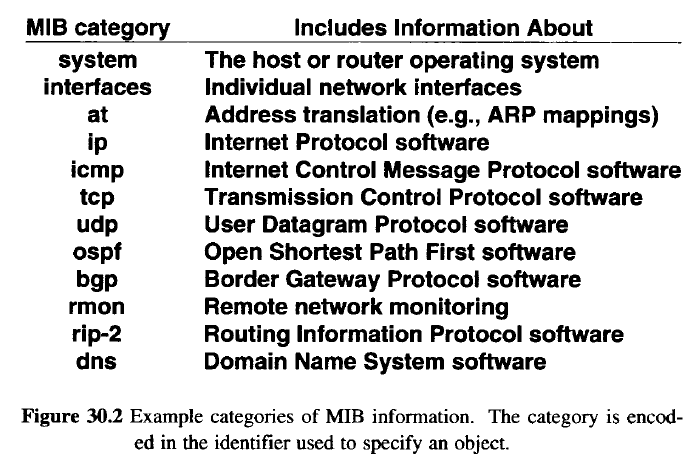30.4 Protocol Framework
TCP/IP network management protocols2 divide the management problem into two parts and specify separate standards for each part. The first part concerns communication of information. A protocol specifies how client software running on a manager's host communicates with an agent. The protocol defines the format and meaning of messages clients and servers exchange as well as the form of names and addresses. The second part concerns the data being managed. A protocol specifies which data items a managed device must keep as well as the name of each data item and the syntax used to express the name.
30.4.1 A Standard Network Management Protocol
The TCP/IP standard for network management is the Simple Network Management Protocol (SNMP). The protocol has evolved through three generations. Consequently,the current version is known as SNMPv3, and the predecessors are known as SNMPvl and SNMPv2. The changes have been minor -- allthree versions use the same generalframework, and many features are backward compatible.
In addition to specifying details such as the message format and the use of transport protocols, the SNMP standard defines the set of operations and the meaning of each. We will see that the approach is minimalistic; a few operations provide all functionality.
30.4.2 A Standard For Managed Information
A device being managed must keep control and status information that the manager can access. For example, a router keeps statistics on the status of its network interfaces, incoming and outgoing packet traffic, dropped datagrams, and error messages generated; a modem keeps statistics about the number of characters sent and received, baud rate, and calls accepted. Although it allows a manager to access statistics, SNMP does not specify exactly which data can be accessed on which devices. Instead, a separate standard specifies the details for each type of device. Known asa Management Information Base (MIB), the standard specifies the data items a managed device must keep, the operations allowed on each, and the meanings. For example, the MIBfor IP specifies that the software must keep a count of all octets that arrive over each network interface and that network management software can only read the count.
The MIB for TCP/IP divides management information into many categories. The choice of categories is important because identifiers used to specify items include a code for the category. Figure 30.2 lists a few examples.

Keeping the MIB definition independent of the network management protocol has advantages for both vendors and users. A vendor can include SNMP agent software in a product such as a router, with the guarantee that the software will continue to adhere to the standard after new MIB items are defined. A customer can use the same network management client software to manage multiple devices that have slightly different versions of a MIB. Of course, a device that does not have new MIB items cannot provide the information in those items. However, because all managed devices use the same language for communication, they can all parse a query and either provide the requested information or send an error message explaining that they do not have the requested item.
2Technically, there is a distinction between internet management protocols and network management protocols. Historically, however, TCP/IP internet management protocols are known as network managementprotocols; we will follow the accepted terminology.
Abstract from Internetworking With TCP/IP Vol I: Principles, Protocols, and Architecture Fourth Edition,
DOUGLAS E. COMER,
Department of Computer Sciences Purdue University, West Lafayette, IN 47907,
PRENTICE HALL,
Upper Saddle River, New Jersey 07458